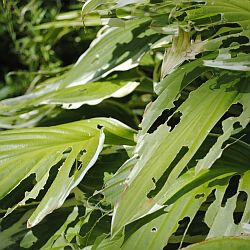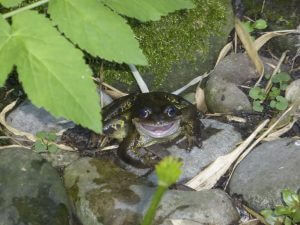The Slug, the Bad and the Ugly
Your essential guide to managing the slug population and keeping sane in your garden this spring, by Jo Dyer
 I know it seems improbable at the moment with the awful weather we’ve been having but it WILL soon warm up and this, combined with all the wet will mean that the gardeners’ nemesis will soon be on the rampage. YES, slugs and snails will start to wreak their usual havoc and have us all either weeping over our hostas or tip-toeing into the chill midnight air in our PJs to gather them up for disposal elsewhere. So, I thought you might appreciate this little guide to help you protect your plants from the worst ravages of slugs and snails this spring (and for the rest of the year).
I know it seems improbable at the moment with the awful weather we’ve been having but it WILL soon warm up and this, combined with all the wet will mean that the gardeners’ nemesis will soon be on the rampage. YES, slugs and snails will start to wreak their usual havoc and have us all either weeping over our hostas or tip-toeing into the chill midnight air in our PJs to gather them up for disposal elsewhere. So, I thought you might appreciate this little guide to help you protect your plants from the worst ravages of slugs and snails this spring (and for the rest of the year).
Slugs and snails start to get active once we’ve had a few spring showers and can be worse after a mild winter because they haven’t had to bunker down so deep in the soil – and more of them survive. We notice the damage more in spring and early summer as we raise our new plants for the veg plot or flower border. It can be really heart breaking to find your small plants munched away with little hope of survival. I do think it’s possible to grow (almost) anything – but it takes patience, know-how and a bit of cunning.
Five strategies – together they form an integrated approach
Choose the first four and use murder as a last resort – slugs and snails are fabulous creatures really and they are part of the food chain. They have their role to play on this earth too – really they do.
- Choice of plants
- Barriers and traps (humane ways to deal with the blighters)
- Natural control – using your garden friends
- The good plant husbandry strategy
- Kill them if you must
Choice of plants
It’s useful to remember that they don’t like to eat everything. As a general rule they tend to avoid those things that have very tough leaves or leaves that contain nasty substances.
Here’s a short list of plants that they tend to avoid. (It’s not gospel so don’t sue me if you’ve tried this without success!)

sedum – crocosmia – hardy geranium – shrubby herbs – roses
Also: Rhododendron, azalea, camelia, laurels including bay – it’s the tough leaves that they dislike. Hellebores, euphorbia, day lily and ornamental grasses – many different kinds.
Control methods
There are pros and cons to all these methods.
Barriers
Things that the slugs don’t like to move over e.g. sharp gravel, egg shells (baked hard so they are really dry), Vaseline smeared on to pots, powders and pellets that dry up the slug mucus making movement difficult, copper tape and copper matting.
We can also include cloches in this category. These can be recycled plastic bottles, or covers that you’ve bought. Save all your bottles for this purpose if you have them. You can remove the bottle during the day when the weather gets warm and replace in the evening to protect at night.
All barriers work by keeping the slugs and snails away from your plants. They can be expensive to use because they need to be replaced regularly. Copper lasts but can be expensive to use over a large area.
The main downside with barriers is that they only work for a very limited time and sometimes not at all. If the weather is wet, barriers are largely ineffective. Some slugs hate copper – others don’t seem bothered by it at all. It’s best to use barriers when you first plant a plant and combine them with other methods. It’s also not easy to accumulate enough cloches. It takes time to put them into place every day and it’s easy to forget to do it.
Use your garden friends – create a wildlife garden
 Slugs and snails are predated by lots of common garden visitors: frogs and toads, newts, hedgehogs, birds like blackbirds and thrushes. Many gardens will have frogs, toads and even newts hiding somewhere – you don’t need a pond. Provide leafy cover in a damp, shady spot and you will often find them. Hedgehogs need a means of access into your garden. Try to persuade your neighbour to leave a hole at the bottom of a fence so they can move between gardens. Provide an area in your garden where a hedgehog can hibernate, shelter or sleep.
Slugs and snails are predated by lots of common garden visitors: frogs and toads, newts, hedgehogs, birds like blackbirds and thrushes. Many gardens will have frogs, toads and even newts hiding somewhere – you don’t need a pond. Provide leafy cover in a damp, shady spot and you will often find them. Hedgehogs need a means of access into your garden. Try to persuade your neighbour to leave a hole at the bottom of a fence so they can move between gardens. Provide an area in your garden where a hedgehog can hibernate, shelter or sleep.
If you have room, plant a couple of trees to give birds somewhere to perch. Plant dense shrubs and hedges for them to nest in. Birds are wonderful predators. They will also control caterpillars, aphids and other ‘pests’.
Plant husbandry
The way you manage the raising, planting and cultivation of plants can affect their chances of survival. Avoid sowing seeds direct into the soil and instead raise plants under cover or in your house (if you can). Grow them to a good size before planting out – then protect them for as long as you can with cloches. Don’t overfeed your plants or force them to grow too quickly. Too much nitrogen will produce soft, lush, leafy growth that the slugs will devour!
This is a good strategy if you have the time and facilities to do it. If you don’t, then buy plants when they have reached a good size. Garden centres stock healthy veg and perennial plants – although you don’t find many organically raised plants for sale at garden centres. Also, remember that a greenhouse doesn’t remain slug-free; you still need to be vigilant!
Killing slugs and snails
I really don’t like killing anything – it goes against my ‘gardening with love’ philosophy, so I try to avoid it wherever possible. I try to come to terms with damage and loss and accept that I don’t have the right to kill things just because they spoil my plants. In the past, I have used the following methods – I use them much less now. They are an absolute final resort not just because they kill slugs and snails but also because they can harm other wildlife too.
Beer traps: These can be useful in the greenhouse as well as in the garden. Sink a container into the soil – leave an inch above the soil to prevent beetles falling in. Traps will attract and kill a small number of slugs but you must empty them regularly as they can smell disgusting. They can also kill beetles and small froglets and it was for this reason that I stopped using them. Beetles and frogs predate small slugs so it’s a bad idea to harm them.
Nematodes: (microscopic worms that invade and kill the slugs). ‘Nemaslug’ will only kill slugs. An effective way to manage a bad slug problem but it won’t kill snails. Simply water them in once the soil has warmed up to 7 degrees C. The soil needs to be wet – after a shower is a good time (but not during spells of heavy rain). The advantage is that slugs deep in the soil will be killed and the general population greatly reduced. There is no evidence of dead slugs so you don’t always know if it has worked.
I have used this to reduce a slug population and then didn’t do it again for a few years. I treated it like a ‘cull’. (This was when I was a Head Gardener where I needed to grow successfully in the veg garden).
Organic slug pellets: I used to use these. However, I decided to stop using them after reading an article (link below) that questions their safety.
Conventional slug pellets: harm wildlife – especially birds and hedgehogs and I don’t use them.
http://www.hostalibrary.org/firstlook/RRIronPhosphate.htm
Jo Dyer
 Really Useful Gardens is a garden consultancy and design business run by Belper resident Jo Dyer, a former Head Organic Gardener. Jo believes passionately in the power of gardens to improve health and well-being through self-expression, connection and creativity. She offers a number of services designed to help you step confidently into action so you can create a garden you’ll love.
Really Useful Gardens is a garden consultancy and design business run by Belper resident Jo Dyer, a former Head Organic Gardener. Jo believes passionately in the power of gardens to improve health and well-being through self-expression, connection and creativity. She offers a number of services designed to help you step confidently into action so you can create a garden you’ll love.
Please visit her website for more details: www.reallyusefulgardens.co.uk or take a peep at her Facebook Page: www.facebook.com/reallyusefulgardens


Great tips! Thanks Jo x